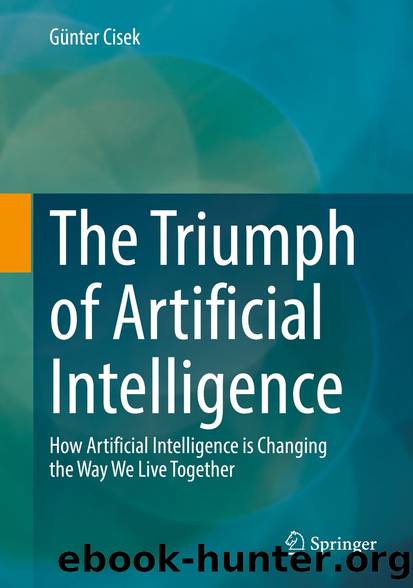The Triumph of Artificial Intelligence by Günter Cisek

Author:Günter Cisek
Language: eng
Format: epub
ISBN: 9783658348960
Publisher: Springer Fachmedien Wiesbaden
Dentifrobots cause desensitization of the teeth and oral analgesia.
Nanorobots bring the drug precisely to the target point in the body
Nanorobots can use the polymer transferrin to recognize and kill tumor cells without harming the healthy cells.
Genetic diseases can be treated by nanorobots by interfering with the molecular structure of the DNA in the defective cells.
These nanites can also be used in the treatment of cerebral aneurysms (protrusion in the wall of a blood vessel in the brain) and in the removal of kidney stones. Such nanosystems can contain magnetic materials, so that these systems can be detected and also controlled from outside with magnetic fields in the human body.92
Remote-controlled robots now make surgeons âcut safeâ by âcalculating awayâ the trembling of his hand.93 The MiroSurge system of the German Aerospace Center is also a tremor-free and precise robotic aid for robot-assisted surgery on the beating heart.94 In the future, mixed and augmented reality applications will even largely eliminate the spatial separation of the screen and the surgical area.95
Nanorobots can also already act as semi-autonomous surgeons on site in the human body these days. For example, a micropipette that vibrates rapidly at a frequency of 100 Hz with a tip diameter of less than 1 μm can be used to cut dendrites from individual neurons. In doing so, it is programmed and guided by human surgeons. The robotic phlebotomist Veebot autonomously performs blood sampling. For this purpose, the fixed arm is scanned with an infrared camera in order to locate the most suitable vein. Only when ultrasound has verified that the vein found is large enough and contains sufficient blood does the robot insert the needle.96
Research leaders Stéphanie Lacour and Grégoire Courtine, together with their team from the Swiss Federal Institute of Technology Lausanne (EPFL), Switzerland, have developed an implant that enables paraplegic rats to regain the ability to walk through a combination of electrical and chemical stimulation and subsequent movement training. The special feature is the flexibility and softness of the material, which can release electrical impulses and pharmacological substances simultaneously.97
In the meantime, people like to talk about ârobo-doctorsâ. However, this is a term that gives the wrong impression. The term âmedical robotâ is probably more appropriate to make it clear that the human doctor is still the sovereign in the operating room.
The company âIntuitive Surgicalâ has already created a possibility of minimally invasive, robot-assisted surgery for the urological and gynaecological field for years with the operating system âDa Vinciâ. The current competitor is called âMiroâ from the Institute of Robotics and Mechatronics of the German Aerospace Center (DLR), which offers similar functionality to Da Vince. Miro can be programmed to avoid putting certain areas of the body at risk. The robot controls the doctorâs hand and stops a slip if necessary. Using remote control with force feedback, the doctor senses how much force he is applying and where there is resistance, as if he were palpating the patient with his finger. The âRenaissanceâ system from Mazor Robotics is only the size of a hand.
Download
This site does not store any files on its server. We only index and link to content provided by other sites. Please contact the content providers to delete copyright contents if any and email us, we'll remove relevant links or contents immediately.
Exploring Deepfakes by Bryan Lyon and Matt Tora(8287)
Robo-Advisor with Python by Aki Ranin(8241)
Offensive Shellcode from Scratch by Rishalin Pillay(6386)
Microsoft 365 and SharePoint Online Cookbook by Gaurav Mahajan Sudeep Ghatak Nate Chamberlain Scott Brewster(5616)
Ego Is the Enemy by Ryan Holiday(5294)
Management Strategies for the Cloud Revolution: How Cloud Computing Is Transforming Business and Why You Can't Afford to Be Left Behind by Charles Babcock(4527)
Python for ArcGIS Pro by Silas Toms Bill Parker(4460)
Elevating React Web Development with Gatsby by Samuel Larsen-Disney(4182)
Machine Learning at Scale with H2O by Gregory Keys | David Whiting(4178)
Liar's Poker by Michael Lewis(3369)
Learning C# by Developing Games with Unity 2021 by Harrison Ferrone(3333)
Speed Up Your Python with Rust by Maxwell Flitton(3280)
OPNsense Beginner to Professional by Julio Cesar Bueno de Camargo(3251)
Extreme DAX by Michiel Rozema & Henk Vlootman(3236)
Agile Security Operations by Hinne Hettema(3160)
Linux Command Line and Shell Scripting Techniques by Vedran Dakic and Jasmin Redzepagic(3151)
Essential Cryptography for JavaScript Developers by Alessandro Segala(3122)
Cryptography Algorithms by Massimo Bertaccini(3057)
AI-Powered Commerce by Andy Pandharikar & Frederik Bussler(3022)
